Neosittoidea Ridgway, 1904
One common thread in most recent analyses of the Corvida is that the sittellas, which were formerly considered whistlers, end up on a branch by themselves. Jønsson (2008b) had the branch occur after the Corvoidea-Malaconotoidea split. Barker et al. (2004) considered them more basal in the Corvida. But they still end up on their own branch. Aggerbeck et al. (2014) have them sister to Eulacestoma, but even they find support for this to be somewhat weak. Most recently, Jønsson et al. (2016) put then basal to the rest of the Malaconotoidea, including Campephagidae. They estimate the split between Neosittidae and the other groups occurred in the mid-Oligocene, about 28 million years ago. As a result, I have placed in their own superfamily. Perhaps we will eventually find they belong in one of the other superfamilies, perhaps not.
Neosittidae: Sittellas Ridgway, 1904
1 genus, 3 species HBW-12
The sittellas are nuthatch-like birds of Australia and New Guinea. Indeed, they were considered nuthatches as late as 1967. They aren't nuthatches, and aren't even members of Passerida. Like many Australasian birds, they are part of Corvida.
- Varied Sittella, Daphoenositta chrysoptera
- Papuan Sittella, Daphoenositta papuensis
- Black Sittella, Daphoenositta miranda
Malaconotoidea Swainson, 1824
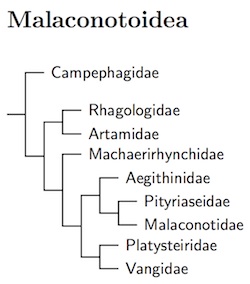 |
| Click for Malaconotoidea genus tree |
|---|
There is a fair amount of consensus between Aggerbeck et al. (2014) and Jønsson et al. (2016) concerning the rest of the Malaconotoidea. Campephagidae is the next branch. The only real issue concerns the posistion of the boatbills (Machaerirhynchidae). Aggerbeck et al. place them sister to Aegithinidae--Vangidae clade. Jønsson et al. (2016) and Fuchs et al. (2012b) put them next to Rhagologus (Rhagologidae). I don't have a good reason to pick either one, so I continue to follow Aggerbeck et al. (2014).
It's interesting to compare the osteological analysis of Manegold (2008) with Fuchs et al. (2012b), or to any of the other molecular analysis. It's something to keep in mind when looking at even the best hypothetical trees for fossil organisms.
It's also interesting that many of the shrike-like birds—helmet-shrikes, bush-shrikes, wood-shrikes, vanga-shrikes, butcherbirds—are included in Malaconotoidea, but the true shrikes are in Corvoidea.
Both the Campephagidae and the Aegithinidae--Vangidae clade represent real breakouts from Australo-Papua. The Campephagidae are widespread in the southern part of the Old World and some of the minivets even reach the eastern Palearctic. The Aegithinidae range to India, the Malaconotidae and Platysteiridae are African, and the Vangidae are concentrated in Madagascar with basal groups in Africa and the Orient.
Campephagidae: Cuckooshrikes Vigors, 1825
12 genera, 93 species HBW-10
The Campephagidae are widespread in the southern portions of the Old World (Afrotropics, Indomalaya, Australasia), but present in only a limited area of the eastern Palearctic.
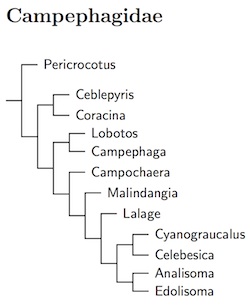 |
| Click for Campephagidae species tree |
|---|
The ordering of the minivets (Pericrocotus) is based on Jønsson et al. (2010b). The results in Fuchs et al. (2007a) and Jønsson et al. (2008a, b) suggested some generic boundaries need to be redrawn for Coracina and related genera. Jønsson et al. (2010c) analyzed most of the revelant taxa, and the current organization is based on their results. Five species of Coracina have been separated as Ceblepyris (Cuvier 1816, type cinereus). See H&M-4 (Dickinson and Christidis, 2014) and Jønsson et al. (2010c, 2016).
They found that several of the Coracina cuckooshrikes were actually closer to some of the trillers (Lalage). They advocate use of a broad genus Lalage including the species listed here in Malindangia, Cyanograucalus, Celebesica, Analisoma, and Edolisoma. The extra genera here serve to highlight the major groups among Lalage and allies. McGregor's Cuckooshrike, Malindangia mcgregori, is basal among them. The rest are in two clades. One includes the species listed below in Lalage. Further division of this did not seem warranted. The other clade probably includes the rest of the Jønsson et al.'s broad Lalage.
The support for grouping Cyanograucalus (Hartlaub, 1861) and Celebesica (Strand, 1928, replacing the preoccupied Celebesia Riley, 1918) is relatively low, so I've put them in separate genera. Indeed, there is some chance they don't even group with the rest of Lalage. I've separated the three Analisoma (Mathews, 1928) because the cicadabirds (Edolisoma, Jacquinot and Pucheran, 1853) form a tight group that is relatively distant from the Analisoma.
The Admiralty Islands Cicadabird, Edolisoma admiralitatis, has been split from Common Cicadabird, Edolisoma tenuirostre (H&M 4; Jønsson et al., 2010c).
There is a deep division (ca. 21 mya) between the minivets and cuckooshrikes. This is recognized by placing the minivets in a separate subfamily, Pericrocotinae.
Pericrocotinae: Minivets Sundevall, 1872
- White-bellied Minivet, Pericrocotus erythropygius
- Jerdon's Minivet, Pericrocotus albifrons
- Small Minivet, Pericrocotus cinnamomeus
- Fiery Minivet, Pericrocotus igneus
- Gray-chinned Minivet, Pericrocotus solaris
- Sunda Minivet, Pericrocotus miniatus
- Short-billed Minivet, Pericrocotus brevirostris
- Little Minivet, Pericrocotus lansbergei
- Long-tailed Minivet, Pericrocotus ethologus
- Orange Minivet, Pericrocotus flammeus
- Scarlet Minivet, Pericrocotus speciosus
- Ryukyu Minivet, Pericrocotus tegimae
- Ashy Minivet, Pericrocotus divaricatus
- Rosy Minivet, Pericrocotus roseus
- Swinhoe's Minivet, Pericrocotus cantonensis
Campephaginae: Cuckooshrikes Vigors, 1825
- Madagascan Cuckooshrike, Ceblepyris cinereus
- Comoros Cuckooshrike, Ceblepyris cucullatus
- Grauer's Cuckooshrike, Ceblepyris graueri
- Gray Cuckooshrike, Ceblepyris caesius
- White-breasted Cuckooshrike, Ceblepyris pectoralis
- Stout-billed Cuckooshrike, Coracina caeruleogrisea
- Hooded Cuckooshrike, Coracina longicauda
- Cerulean Cuckooshrike, Coracina temminckii
- Ground Cuckooshrike, Coracina maxima
- Pied Cuckooshrike, Coracina bicolor
- Barred Cuckooshrike, Coracina lineata
- Boyer's Cuckooshrike, Coracina boyeri
- Black-faced Cuckooshrike, Coracina novaehollandiae
- North Melanesian Cuckooshrike, Coracina welchmani
- White-bellied Cuckooshrike, Coracina papuensis
- Manus Cuckooshrike, Coracina ingens
- Javan Cuckooshrike, Coracina javensis
- Wallacean Cuckooshrike, Coracina personata
- Buru Cuckooshrike, Coracina fortis
- Moluccan Cuckooshrike, Coracina atriceps
- South Melanesian Cuckooshrike, Coracina caledonica
- Large Cuckooshrike, Coracina macei
- Bar-bellied Cuckooshrike, Coracina striata
- Andaman Cuckooshrike, Coracina dobsoni
- Sunda Cuckooshrike, Coracina larvata
- Slaty Cuckooshrike, Coracina schistacea
- White-rumped Cuckooshrike, Coracina leucopygia
- Western Wattled-Cuckooshrike, Lobotos lobatus
- Eastern Wattled-Cuckooshrike, Lobotos oriolinus
- Black Cuckooshrike, Campephaga flava
- Red-shouldered Cuckooshrike, Campephaga phoenicea
- Petit's Cuckooshrike, Campephaga petiti
- Purple-throated Cuckooshrike, Campephaga quiscalina
- Golden Cuckooshrike, Campochaera sloetii
- McGregor's Cuckooshrike, Malindangia mcgregori
- Polynesian Triller, Lalage maculosa
- Samoan Triller, Lalage sharpei
- Long-tailed Triller, Lalage leucopyga
- White-shouldered Triller, Lalage sueurii
- White-winged Triller, Lalage tricolor
- Rufous-bellied Triller, Lalage aurea
- Black-browed Triller, Lalage atrovirens
- White-browed Triller, Lalage moesta
- Varied Triller, Lalage leucomela
- Mussau Triller, Lalage conjuncta
- Black-and-white Triller, Lalage melanoleuca
- Pied Triller, Lalage nigra
- White-rumped Triller, Lalage leucopygialis
- Mauritius Cuckooshrike, Lalage typica
- Reunion Cuckooshrike, Lalage newtoni
- Black-winged Cuckooshrike, Lalage melaschistos
- Black-headed Cuckooshrike, Lalage melanoptera
- Indochinese Cuckooshrike, Lalage polioptera
- Lesser Cuckooshrike, Lalage fimbriata
- Blue Cuckooshrike, Cyanograucalus azureus
- Pygmy Cuckooshrike, Celebesica abbotti
- Halmahera Cuckooshrike, Celebesica parvula
- New Caledonian Cuckooshrike, Analisoma anale
- Blackish Cuckooshrike, Analisoma coerulescens
- White-winged Cuckooshrike, Analisoma ostentum
- Black-bellied Cuckooshrike, Edolisoma montanum
- Kai Cicadabird, Edolisoma dispar
- Pale-shouldered Cicadabird, Edolisoma dohertyi
- Pale Cicadabird, Edolisoma ceramense
- Black-bibbed Cicadabird, Edolisoma mindanense
- Admiralty Islands Cicadabird, Edolisoma admiralitatis
- Makira Cicadabird, Edolisoma salomonis
- Black-bellied Cicadabird / Solomons Cuckooshrike, Edolisoma holopolium
- Black-shouldered Cicadabird, Edolisoma incertum
- Gray-headed Cuckooshrike, Edolisoma schisticeps
- Black Cicadabird, Edolisoma melas
- Sulawesi Cicadabird, Edolisoma morio
- Gray-capped Cicadabird, Edolisoma remotum
- Sula Cicadabird, Edolisoma sula
- Common Cicadabird, Edolisoma tenuirostre
- Palau Cicadabird, Edolisoma monacha
- Yap Cicadabird, Edolisoma nesiotis
- Pohnpei Cicadabird, Edolisoma insperatum
Rhagologidae: Mottled Berryhunter Schodde and Christidis, 2014
1 genus, 1 species Not HBW Family (HBW-12:411)
This family includes one species, the Papuan endemic Mottled Berryhunter (formerly Mottled Whistler). Jønsson et al. (2016) recommended treating it as a separate family. Aggerbeck et al. (2014) considered it sister to Artamidae, with the boatbills closer to the Aegithinidae/Vangidae clade. Support for any particular position of the Mottled Berryhunter and the boatbills is weak in all studies. The arrangement here is that of Jønsson et al. (2016). No one would be surprised if actually belong elsewhere in Malaconotoidea.
- Mottled Berryhunter, Rhagologus leucostigma
Artamidae: Woodswallows, Butcherbirds Hartlaub, 1877
6 genera, 26 species HBW-14
This family includes the Australo-Papuan Cracticinae, and the more widespread Artaminae (woodswallows) that range from India to Australasia.
I now follow Christidis and Boles (2008) by including the woodswallows, butcherbirds, and currawongs in the same family. There is an increasing body of genetic evidence that they form a clade. Baker et al. (2004) and Moyle et al. (2004b) placed them in the same clade. The extra structure is handled by ranking the woodswallows (Artaminae), and butcherbirds and currawongs (Cracticinae) as subfamilies.
Peltops seems to be closer to the butcherbirds than the woodswallows (Jønsson et al., 2010c, 2011b; Fuchs et al., 2012b, Kearns et al., 2013), so it is included in Cracticinae. Kearns et al. (2013) found that the actual species boundaries within Peltops do not seem to match current thinking. There are two species, but the division is not as expected.
The genus Gymnorhina (Australian Magpie) has been merged with Cracticus and Strepera has been reordered based on Kearns et al. (2013). The Black Butcherbird has been split into New Guinea Black-Butcherbird, Cracticus quoyi, and Australian Black-Butcherbird, Cracticus spaldingi. Kearns et al. (2011) found substantial genetic distance between these allopatric groups of taxa.
The gray (a.k.a. white-throated) Butcherbird group continues to be controversial. Kearns et al. (2013) found little genetic distance between them and relationships that did not match the traditional allopatric species in the group. Recognition of the Silver-backed Butcherbird, Cracticus argenteus, has always been controversial, but the Black-backed Butcherbird, Cracticus mentalis, has been considered a separate species. Kearns et al. (2013) found that some argenteus grouped with mentalis and some grouped with torquatus. All were genetically close, with a common ancestor probably about 200,000 years ago. Because of this I, had lumped them with the Gray Butcherbird, Cracticus torquatus. However, that is not the end of the story. Kearns et al. (2014) increased sampling of both individuals and nuclear genes. They found significant conflict between the mitochondrial and nuclear dna. However, the species tree made sense, and current geneflow is modest, so I have returned to treating them as three species.
Artaminae: Woodswallows Hartlaub, 1877
- Ashy Woodswallow, Artamus fuscus
- White-breasted Woodswallow, Artamus leucorynchus
- Fiji Woodswallow, Artamus mentalis
- Ivory-backed Woodswallow, Artamus monachus
- Great Woodswallow, Artamus maximus
- White-backed Woodswallow, Artamus insignis
- Masked Woodswallow, Artamus personatus
- White-browed Woodswallow, Artamus superciliosus
- Black-faced Woodswallow, Artamus cinereus
- Dusky Woodswallow, Artamus cyanopterus
- Little Woodswallow, Artamus minor
Cracticinae: Butcherbirds & allies Chenu & des Murs, 1853 (1836)
- Clicking Shieldbill / Lowland Peltops, Peltops blainvillii
- Tinkling Shieldbill / Mountain Peltops, Peltops montanus
- Black Currawong, Strepera fuliginosa
- Gray Currawong, Strepera versicolor
- Pied Currawong, Strepera graculina
- Australian Magpie, Cracticus tibicen
- New Guinea Black-Butcherbird, Cracticus quoyi
- Australian Black-Butcherbird, Cracticus spaldingi
- Pied Butcherbird, Cracticus nigrogularis
- Hooded Butcherbird, Cracticus cassicus
- Tagula Butcherbird, Cracticus louisiadensis
- Black-backed Butcherbird, Cracticus mentalis
- Gray Butcherbird, Cracticus torquatus
- Silver-backed Butcherbird, Cracticus argenteus
Machaerirhynchidae: Boatbills Schodde & Mason, 1999
1 genus, 2 species HBW-14
Jønsson et al. (2016) place this small Australo-Papuan group sister to the Artamidae.
- Yellow-breasted Boatbill, Machaerirhynchus flaviventer
- Black-breasted Boatbill, Machaerirhynchus nigripectus
Aegithinidae: Ioras G.R. Gray, 1869
1 genus, 4 species HBW-10
The ioras range from India to Borneo.
- Common Iora, Aegithina tiphia
- Marshall's Iora, Aegithina nigrolutea
- Green Iora, Aegithina viridissima
- Great Iora, Aegithina lafresnayei
Pityriaseidae: Bristlehead Mayr & Amadon, 1951
1 genus, 1 species HBW-14
Moyle et al. (2006b) was the first to find that the Bornean Bristlehead belonged to the Malaconotoidea. This arrangement with the Bristlehead sister to the Malaconotidae family is based on Fuchs et al. (2012b) and also supported by Aggerbeck et al. (2014) and Jønsson et al. (2016). The last recommend including it in Malaconotidae.
- Bornean Bristlehead, Pityriasis gymnocephala
Malaconotidae: Bush-shrikes, Puffbacks Swainson, 1824
8 genera, 49 species HBW-14
The overall structure of Malaconotidae follows Fuchs et al. (2012b). Laniarius has been reordered using Nguembock et al. (2008c). Based on their work, the Black Boubou, Laniarius nigerrimus (erlangeri is a junior synonym), and East Coast Boubou, Laniarius sublacteus, have been split from Tropical Boubou, Laniarius aethiopicus. They also found that the Bulo Burti Boubou, Laniarius liberatus, was a color morph of the Black Boubou, Laniarius nigerrimus. Finally, Tropical Boubou, Laniarius aethiopicus, is split into Tropical Boubou, Laniarius major, and Ethiopian Boubou, Laniarius aethiopicus. I would expect more changes for this genus in the future.
The current consensus seems to be that the Four-colored Bushshrike, Telophorus quadricolor, is better treated as a subspecies of the Gorgeous Bushshrike, Telophorus viridis. E.g., Dowsett, R.J., and F. Dowsett-Lemaire (1993), H&M-4 (Dickinson and Christidis, 2014), HBW Alive, Clements 6,9, IOC-5.3.
Following the recommendations of Fuchs et al. (2004), Rhodophoneus has been submerged in Telophorus, as have the undergrowth species of Chlorophoneus (dohertyi and viridis).
- Brubru, Nilaus afer
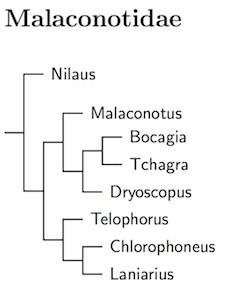
Click for Malaconotidae tree - Fiery-breasted Bushshrike, Malaconotus cruentus
- Monteiro's Bushshrike, Malaconotus monteiri
- Gray-headed Bushshrike, Malaconotus blanchoti
- Lagden's Bushshrike, Malaconotus lagdeni
- Green-breasted Bushshrike, Malaconotus gladiator
- Uluguru Bushshrike, Malaconotus alius
- Marsh Tchagra, Bocagia minuta
- Brown-crowned Tchagra, Tchagra australis
- Three-streaked Tchagra, Tchagra jamesi
- Southern Tchagra, Tchagra tchagra
- Black-crowned Tchagra, Tchagra senegalus
- Sabine's Puffback, Dryoscopus sabini
- Pink-footed Puffback, Dryoscopus angolensis
- Red-eyed Puffback, Dryoscopus senegalensis
- Black-backed Puffback, Dryoscopus cubla
- Northern Puffback, Dryoscopus gambensis
- Pringle's Puffback, Dryoscopus pringlii
- Rosy-patched Bushshrike, Telophorus cruentus
- Bokmakierie, Telophorus zeylonus
- Doherty's Bushshrike, Telophorus dohertyi
- Gorgeous Bushshrike, Telophorus viridis
- Mount Kupe Bushshrike, Chlorophoneus kupeensis
- Many-colored Bushshrike, Chlorophoneus multicolor
- Black-fronted Bushshrike, Chlorophoneus nigrifrons
- Olive Bushshrike, Chlorophoneus olivaceus
- Bocage's Bushshrike, Chlorophoneus bocagei
- Orange-breasted Bushshrike, Chlorophoneus sulfureopectus
- Willard's Sooty Boubou, Laniarius willardi
- Crimson-breasted Shrike, Laniarius atrococcineus
- Lowland Sooty-Boubou, Laniarius leucorhynchus
- Mountain Sooty-Boubou, Laniarius poensis
- Fuelleborn's Boubou, Laniarius fuelleborni
- Red-naped Bushshrike, Laniarius ruficeps
- Black Boubou, Laniarius nigerrimus
- Slate-colored Boubou, Laniarius funebris
- Yellow-crowned Gonolek, Laniarius barbarus
- Black-headed Gonolek, Laniarius erythrogaster
- Papyrus Gonolek, Laniarius mufumbiri
- Yellow-breasted Boubou, Laniarius atroflavus
- Luehder's Bushshrike, Laniarius luehderi
- Braun's Bushshrike, Laniarius brauni
- Gabela Bushshrike, Laniarius amboimensis
- Tropical Boubou, Laniarius major
- Ethiopian Boubou, Laniarius aethiopicus
- Turati's Boubou, Laniarius turatii
- Swamp Boubou, Laniarius bicolor
- East Coast Boubou, Laniarius sublacteus
- Southern Boubou, Laniarius ferrugineus
Platysteiridae: Wattle-eyes, Batises Sundevall, 1872
5 genera, 31 species HBW-11
I had earlier followed the recommendation of Njabo et al. (2008) and merged Dyaphorophyia into Platysteira. However, further analysis by Fuchs et al. (2012b) revealed that things are not quite so simple. Their results call into question whether Batis itself is monophyletic. They found four deep clades separated by very short internodes. Two parts of Batis, the restricted Dyaphorophyia used here, and Platysteira (which includes part of the former Dyaphorophyia). Although their species tree says Batis is not monophyletic, I find that hard to believe and leave Batis as a single genus.
The overall order here is based on Njabo et al. (2008), Fuchs et al. (2012b), and Jønsson et al. (2016) together with a lot of guesswork. It is clear that some of the putative Batis superspecies involve birds that are not closely related. What is not clear is how to put them back together. Batises are very confusing! Nine species of Batis have been placed in the temporary genus "Batis".
The Western Black-headed Batis has been moved from Batis to Lanioturdus, as Lanioturdus erlangeri, based on Jønsson et al. (2016).
Njabo et al. (2008) found that the West African Wattle-eye, Platysteira hormophora, formerly considered a subspecies of Chestnut Wattle-eye, Platysteira castanea, is only distantly related to it.
- Western Black-headed Batis, Lanioturdus erlangeri
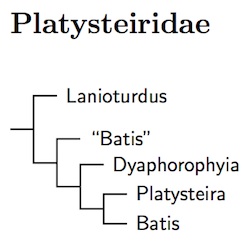
Click for Platysteiridae tree - White-tailed Shrike, Lanioturdus torquatus
- Pygmy Batis, Batis perkeo
- Eastern Black-headed Batis, Batis minor
- Senegal Batis, Batis senegalensis
- Pririt Batis, Batis pririt
- Pale Batis, Batis soror
- Fernando Po Batis, Batis poensis
- Angolan Batis, Batis minulla
- Gabon Batis, Batis minima
- Ituri Batis, Batis ituriensis
- White-spotted Wattle-eye, Dyaphorophyia tonsa
- West African Wattle-eye, Dyaphorophyia hormophora
- Chestnut Wattle-eye, Dyaphorophyia castanea
- Yellow-bellied Wattle-eye, Platysteira concreta
- Red-cheeked Wattle-eye, Platysteira blissetti
- Black-necked Wattle-eye, Platysteira chalybea
- Jameson's Wattle-eye, Platysteira jamesoni
- Brown-throated Wattle-eye, Platysteira cyanea
- White-fronted Wattle-eye, Platysteira albifrons
- Black-throated Wattle-eye, Platysteira peltata
- Banded Wattle-eye, Platysteira laticincta
- Gray-headed Batis, Batis orientalis
- Chinspot Batis, Batis molitor
- Ruwenzori Batis, Batis diops
- Margaret's Batis, Batis margaritae
- Forest Batis, Batis mixta
- Dark Batis, Batis crypta
- Cape Batis, Batis capensis
- Reichenow's Batis, Batis reichenowi
- Woodward's Batis, Batis fratrum
Vangidae: Vangas Swainson, 1831
21 genera, 39 species HBW-14
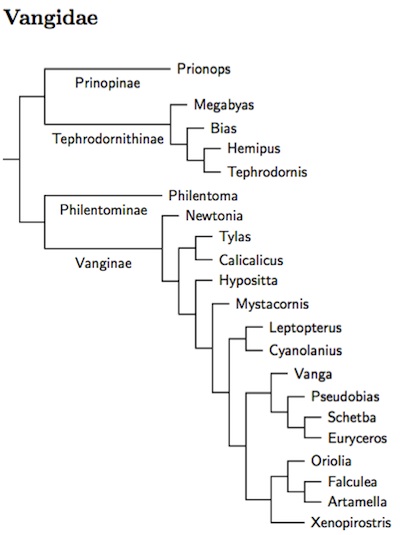 Although H&M 4 (Dickinson and Christidis, 2014) includes the helmetshrikes
(Prionopidae) and woodshrikes, shrike-flycatchers, and Flycatcher-shrikes
(Tephrodornithdae) in Vangidae. IOC 5.4 continues following a more traditional
treatment of this group. They use three families: Prionopidae (Helmetshrikes),
Tephrodornithdae (Woodshrikes and allies), and Vangidae, with Vangidae separated
from the others. They also place Megabyas and Bias in
Platysteiridae. Some years ago, I had described traditional arrangements as
“hard to justify on molecular grounds”. But now, thanks to Reddy et
al. (2012), Jønsson et al. (2012b, 2016), and Fuchs et al. (2012b), I can
say it's just wrong.
Although H&M 4 (Dickinson and Christidis, 2014) includes the helmetshrikes
(Prionopidae) and woodshrikes, shrike-flycatchers, and Flycatcher-shrikes
(Tephrodornithdae) in Vangidae. IOC 5.4 continues following a more traditional
treatment of this group. They use three families: Prionopidae (Helmetshrikes),
Tephrodornithdae (Woodshrikes and allies), and Vangidae, with Vangidae separated
from the others. They also place Megabyas and Bias in
Platysteiridae. Some years ago, I had described traditional arrangements as
“hard to justify on molecular grounds”. But now, thanks to Reddy et
al. (2012), Jønsson et al. (2012b, 2016), and Fuchs et al. (2012b), I can
say it's just wrong.
The four multi-gene analyses provide strong evidence that Vangidae, as constituted here, is monophyletic. While there remains a possibility that another vanga or two may be hiding in some other family, all the known suspects have been tested. The current arrangement of genera is based on Reddy et al. (2012) and the arrangement within some of the genera follows Jønsson et al. (2012b).
There remains uncertainty about where Philentoma fits. Jønsson et al. (2016) consider it the basal group, rather than sister to the subfamily Vanginae. Reddy et al. (2012) tried various alternative analyses, sometimes finding Philentoma in a different position.
Previously, the papers by Yamagishi et al. (2001), Fuchs et al. (2004, 2006b, 2007a), Moyle et al. (2006b), and Johansson et al. (2008a) help clarify the relation between the vangas (Vangidae), the wattle-eyes and batises (Platysteiridae), and the bush-shrikes (Malaconotidae).
Some genera have moved around, mostly in or out of Vangidae. Compared to the treatment of Dickinson et al. (2003), Vangidae gained Prionops from Malaconotidae, Megabyas and Bias from Platysteiridae, Hemipus from Campephagidae, and the uncertainly placed Tephrodornis and Philentoma. Stepping back a couple of years: Tylas was sometimes considered a bulbul (although correctly identified as a vanga by Beecher, 1953), Newtonia was thought to be a Sylviioid or Muscicapoid, and Hypositta was considered a Parid or Sittid. For those interested in examing an old taxonomy of the Passerida, I recommend taking a look at the diagram on page 324 of Beecher. Johansson et al. (2008a) show convincingly that Mystacornis is a vangid (Crossley's Vanga, formerly Crossley's Babbler).
Prionopinae: Helmetshrikes Bonaparte, 1853
- White-crested Helmetshrike, Prionops plumatus
- Gray-crested Helmetshrike, Prionops poliolophus
- Yellow-crested Helmetshrike, Prionops alberti
- Red-billed Helmetshrike, Prionops caniceps
- Rufous-bellied Helmetshrike, Prionops rufiventris
- Retz's Helmetshrike, Prionops retzii
- Gabela Helmetshrike, Prionops gabela
- Chestnut-fronted Helmetshrike, Prionops scopifrons
Tephrodornithinae: Woodshrikes, Shrike-flycatchers Informal
Some internet sources claim that Tephrodornithidae is due to Moyle et al. (2006b). Although they did notice the clade, they did not use the term Tephrodornithidae, and it remains an informal name.
- African Shrike-flycatcher, Megabyas flammulatus
- Black-and-white Shrike-flycatcher, Bias musicus
- Bar-winged Flycatcher-shrike, Hemipus picatus
- Black-winged Flycatcher-shrike, Hemipus hirundinaceus
- Common Woodshrike, Tephrodornis pondicerianus
- Sri Lanka Woodshrike, Tephrodornis affinis
- Malabar Woodshrike, Tephrodornis sylvicola
- Large Woodshrike, Tephrodornis virgatus
Philentominae: Philentomas Informal
Although the Philentomas could be included in Vanginae, it makes sense to separate these southeast Asian species from the Madagascan vangas.
- Maroon-breasted Philentoma, Philentoma velata
- Rufous-winged Philentoma, Philentoma pyrhoptera
Vanginae: Vangas Swainson, 1831
- Archbold's Newtonia, Newtonia archboldi
- Common Newtonia, Newtonia brunneicauda
- Dark Newtonia, Newtonia amphichroa
- Red-tailed Newtonia, Newtonia fanovanae
- Tylas Vanga, Tylas eduardi
- Red-tailed Vanga, Calicalicus madagascariensis
- Red-shouldered Vanga, Calicalicus rufocarpalis
- Nuthatch Vanga, Hypositta corallirostris
- Crossley's Vanga, Mystacornis crossleyi
- Chabert Vanga, Leptopterus chabert
- Blue Vanga, Cyanolanius madagascarinus
- Hook-billed Vanga, Vanga curvirostris
- Ward's Flycatcher, Pseudobias wardi
- Rufous Vanga, Schetba rufa
- Helmet Vanga, Euryceros prevostii
- Bernier's Vanga, Oriolia bernieri
- Sickle-billed Vanga, Falculea palliata
- White-headed Vanga, Artamella viridis
- Pollen's Vanga, Xenopirostris polleni
- Lafresnaye's Vanga, Xenopirostris xenopirostris
- Van Dam's Vanga, Xenopirostris damii